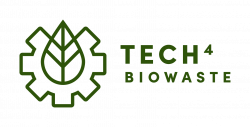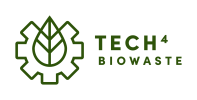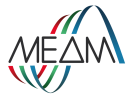Microwave treatment
| Technology | |

| |
| Technology details | |
| Name: | Microwave pre-treatment |
| Category: | Pre-processing (Physical processes and technologies), Post-processing (Physical processes and technologies) |
| Feedstock: | Food and kitchen waste (lignocellulosic materials), Garden and park waste (lignocellulosic materials) |
| Product: | Fermentable sugar |
For microwave (MW) treatment electromagnetic radiation is used to induce thermal and non-thermal effects that drive physical, chemical or biological reactions[1]. As a rapid and effective heating source with both thermal and non-thermal effects, MW can directly interact with the material, thereby accelerating chemical, physical, and biologic reactions.[2] Microwave treatment causes a rise in the temperature within a penetrated medium as a result of rapid changes of the electromagnetic field at high frequency.[3] The technology is usually applied in food drying or to break down the structure of lignocellulosic biowaste leading to the release of different substances, such as fermentable sugars.
Feedstock
Origin and composition
Microwave irradiation has been successfully used in the pretreatment of several biowaste streams, including agricultural residues, woody biomass, grass, energy plants, and industrial residuals.[4]
Pre-treatment
Process and technologies
The breakdown of lignocellulosic biomass into its monomers and oligomers is induced via molecular collision due to dielectric polarisation[5]. Compared to other thermal treatments, the technology brings several advantages, such as reduced plant footprint, higher throughput, higher reaction rates, as well as higher yield and purity[1]. However, a disadvantage is the unequal distribution of the applied microwave power through non-homogeneous material (such as differences in composition, geometry, or size) as well as local overheating through resonance (electromagnetic wave reflection and formation of standing waves) and low penetration for bulk materials [5].
The process can also be combined with chemicals such as alkaline (to remove lignin), acid (to remove hemicellulose), ammonia, and metal salts[1].
Product
- Fermentable sugar (e.g. for bio-alcohol production)
Post-treatment
Technology providers
| Company name | Country | Technology subcategory | Technology name | TRL | Capacity [kg/h] | Temperature [°C] | Frequency [GHz] | Power [W] | Penetration depth [cm] | Processable volume [L] | Feedstock: Food waste | Feedstock: Garden & park waste |
|---|---|---|---|---|---|---|---|---|---|---|---|---|
| Biorenewables Development Centre | United Kingdom | - | Microwave furnaces | - | 30 | - | - | 6 | - | - | ● | ● |
| Biowave Technologies | Ireland | - | Microwave pre-treatment | 7 | 500-8000 | - | 0.915 | 30,000-300,000 | - | 500-8000 | ● | ● |
| Endeavour Energia Srl | Italy | - | Endeavour Microwave Gasification | 6 | 100 | >1400 | - | 100,000-200,000 | - | ● | ● | |
| MEAM International | Belgium and the Netherlands | - | MEAM Dry series (HR) | 9 | 1000 to 150,000 | 40 to 120 | 0.915, 2.45, and 5.8 | 10,000 to 500,000 | 2 to 30 | - | ● | ● |
Biorenewables Development Centre
| General information | |||
| Company: | Biorenewables Development Centre | ||
| Country: | United Kingdom | ||
| Contact: | Anna Alessi | ||
| Webpage: | http://www.biorenewables.org | ||
| Technology and process details | |||
| Technology name: | Microwave furnaces | Technology category: | Pre-processing (Physical processes and technologies), Post-processing (Physical processes and technologies) |
| TRL: | up to 8 | Capacity: | 30 kg·h-1 |
| Frequency: | GHz | Penetration depth: | cm |
| Power: | 6 W | Processable volume: | various L |
| Temperature: | up to 1000C °C | Other: | |
| Feedstock and product details | |||
| Feedstock: | lignocellulose biomass | Product: | biochar, oil |
The Biorenewables Development Centre (BDC) has a long history of working with microwave technology for synthesis, extraction, hydrolysis and pyrolysis. Our microwave pyrolysis unit can pyrolyse a variety of biomass which can then be separated into bio-char and fractionated bio-oil using the integral product collection system. Our pyrolysis microwave unit is capable of continuous flow up to 30 kg/hour at variable power (6 kW) and has been custom built by SAIREM for the BDC. This machine is capable of continuous flow up to 30 kg/hour at variable power (6 kW) and has been custom built by SAIREM for the BDC. This unique patented technology was developed here at York and is particularly novel as it is a low temperature method (less than 200°C) and separates the bio-oil products into more useful groups. The second unit at the BDC is the Carbolite custom furnace - a continuous Inconel tube system with a designed temperature limit of 1000 °C. It allows the heating up of organic material in the absence of oxygen. This furnace has a 50 litre hopper and a heated section length of 2 metres with three programmable heated sections. Material is fed through the furnace via an auger system and can be ran in either continuous or batch mode. The throughput of the furnace is dependent on the material being processed, however there is a 60 litre collection bin and a 20 litre collection pot for any by-products being produced.
Biowave Technologies
| General information | |||
| Company: | Biowave Technologies | 
| |
| Country: | Ireland | ||
| Contact: | info@biowave-tech.com | ||
| Webpage: | www.biowave-tech.com | ||
| Technology and process details | |||
| Technology name: | Microwave pre-treatment | Technology category: | Pre-processing (Physical processes and technologies), Post-processing (Physical processes and technologies) |
| TRL: | 7 | Capacity: | 500-8000 kg·h-1 |
| Frequency: | 0.915 GHz | Penetration depth: | cm |
| Power: | 30,000-300,000 W | Processable volume: | 500-8000 L |
| Temperature: | °C | Other: | |
| Feedstock and product details | |||
| Feedstock: | Dairy processing waste, FOG waste, waste activated sludge, agricultural residues, food waste | Product: | Digestible feedstock for AD |
Biowave Technologies transform organic waste streams into renewable energy resources.
Endeavour Energia Srl
| General information | |||
| Company: | Endeavour Energia Srl | 
| |
| Country: | Italy | ||
| Contact: | |||
| Webpage: | http://www.endeavoursrl.com/ | ||
| Technology and process details | |||
| Technology name: | Endeavour Microwave Gasification | Technology category: | Pre-processing (Physical processes and technologies), Post-processing (Physical processes and technologies) |
| TRL: | 6 | Capacity: | 100 kg·h-1 |
| Frequency: | GHz | Penetration depth: | cm |
| Power: | 100 - 200 k W | Processable volume: | L |
| Temperature: | >1400 °C | Other: | |
| Feedstock and product details | |||
| Feedstock: | Rice and wheat husks, anaerobic digestion digestate, animal litter, woody biomass. | Product: | Syngas and biochar |
Endeavor Srl. was born in 2015 as an innovative start-up with a clear project: to design and build a plant capable of transforming biomass and waste into electrical and thermal energy through an innovative and patented technology based on microwaves.
The Endeavour Microwave Gasification technology by Endeavour Energia S.r.l. can be used to upgrade waste and biomass feeds, such as rice and wheat husks, woody biomass, sludge from anaerobic digestion and litter from animal farms to electricity, heat, and biochar. According to Endeavour, the technology is characterized by the use of microwave-assisted high temperature gasification (>1400 °C) together with a simplified filtering system in a setup that does not generate waste in need of disposal.
MEAM International
| General information | |||
| Company: | MEAM International | 
| |
| Country: | Belgium and the Netherlands | ||
| Contact: | Kendra.Rademaker@meam-international.com | ||
| Webpage: | https://meam-international.com/ | ||
| Technology and process details | |||
| Technology name: | MEAM Dry series (HR) | Technology category: | Pre-processing (Physical processes and technologies), Post-processing (Physical processes and technologies) |
| TRL: | 4 - 9 (depending on specific case) | Capacity: | 1000 to 150,000 kg·h-1 |
| Frequency: | 0.915, 2.45, and 5.8 GHz | Penetration depth: | 2 - 30 cm |
| Power: | 10 kW to 500 k W | Processable volume: | L |
| Temperature: | 40 to 120 °C | Other: | Combination with vacuum chamber is possible |
| Feedstock and product details | |||
| Feedstock: | Different industrial food and non-food applications. | Product: | Drying, conditioning, heating. |
MEAM was founded over 10 years ago by the electronic engineer specialising in high-power EM energy Carlo Groffils. Since then, MEAM has become an international player with offices in Belgium and the Netherlands and successfully delivered over 350 microwave projects to both large and small enterprises. MEAM's focus lies today on the food industry, as well as industrial microwave processing of wood, glass and plastics, and water and solvent-based paint, coating and drying in technical applications. Depending on the process, it is possible to recover the heat from the cooling water or exhaust air to defrost or preheat the product. Combinations with vacuum chambers are also possible.
MEAM can deliver a variety of systems, with a wide variety of process details ranging from TRL 4 to 9. The specific conditions will depend on the exact product and process requirements. To ensure the optimal conditions, MEAM works together with clients for a technical and economic feasibility study. A parametric study will be performed to ensure the optimal conditions will be used in the final set up. Next to the listed processes, MEAM is continuously innovating and working on expanding the range of solutions.
Once a month a training day is organised by MEAM to teach the foundations of the technology and get hands-on experience. Visit the website for more information on the training day.
Open access pilot and demo facility providers
Currently no providers have been identified.
Patents
Currently no patents have been identified.
References
- ↑ a b c Ethaib, S., Omar, R., Kamal, S. M. M., Biak, D. R. A., 2015: MICROWAVE-ASSISTED PRETREATMENT OF LIGNOCELLULOSICBIOMASS: A REVIEW. Journal of Engineering Science and Technology, Vol. January (2015), 97-109. doi: https://doi.org/
- ↑ Jian Xu, 2014: Microwave Pretreatment. Pretreatment of Biomass: Processes and Technologies. Ashok Pandey, Sangeeta Negi, Parmeswaran Binod, Christian Larroche (Ed.). Elsevier, Amsterdam.
- ↑ Anthony R. Bird, Amparo Lopez-Rubio, Ashok K. Shrestha, Michael J. Gidley, 2009: Resistant Starch in Vitro and in Vivo: Factors Determining Yield, Structure, and Physiological Relevance. Modern Biopolymer Science. Stefan Kasapis, Ian T. Norton, Johan B. Ubbink (Ed.). Elsevier, Amsterdam.
- ↑ Ashok Pandey, Sangeeta Negi, Parameswaran Binod, Christian Larroche, 2014: Chapter 9 - Microwave Pretreatment. Pretreatment of biomass : processes and technologies. {{{editor}}} (Ed.). Elsevier BV, Amsterdam.
- ↑ a b Alejandra Aguilar-Reynosa, Aloia Romaní, Rosa Ma. Rodríguez-Jasso, Cristóbal N. Aguilar, Gil Garrote, Héctor A. Ruiz, 2017-03: Microwave heating processing as alternative of pretreatment in second-generation biorefinery: An overview. Energy Conversion and Management, Vol. 136, 50–65. doi: https://doi.org/10.1016/j.enconman.2017.01.004